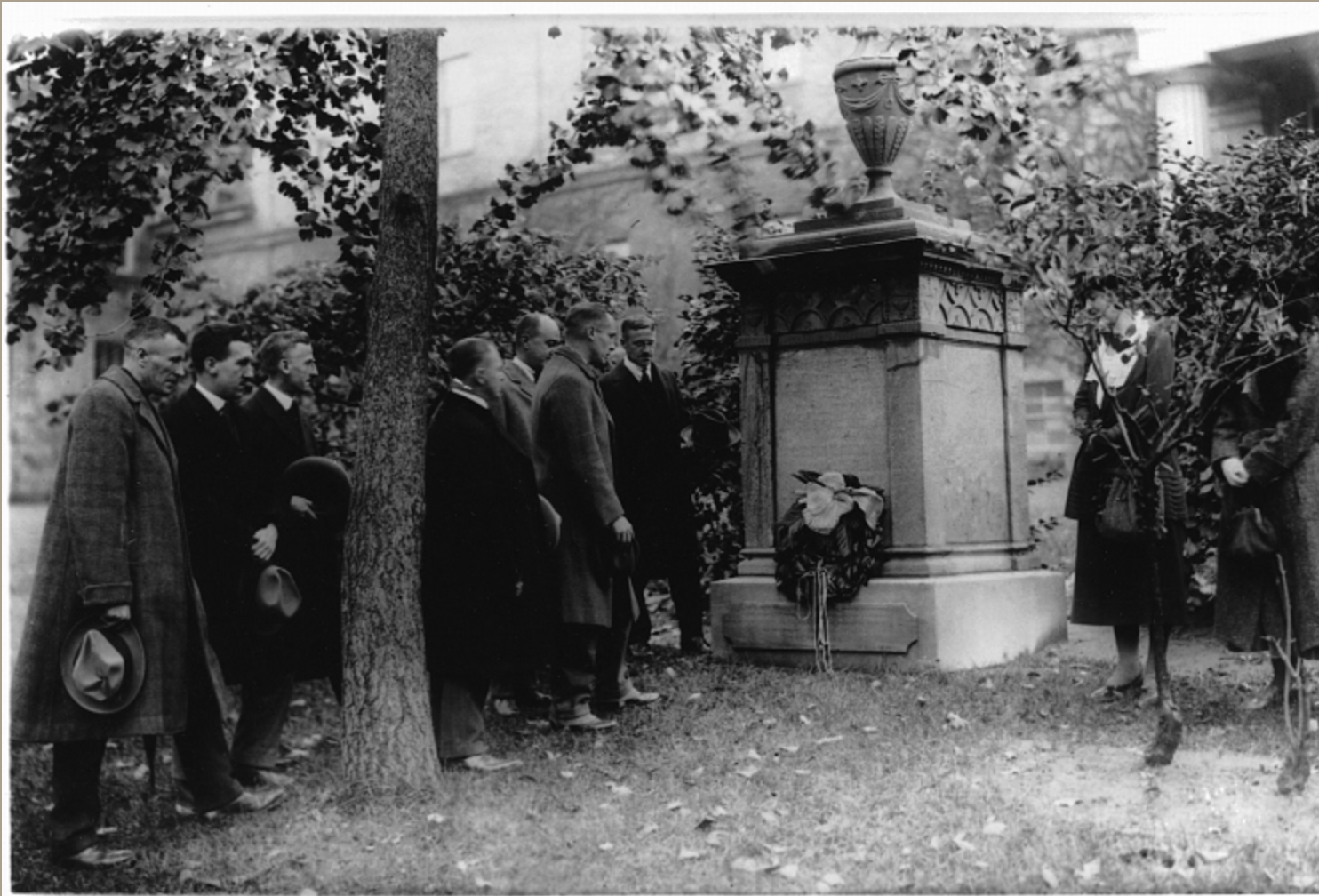[timeline_excerpt][content warning for racist language]
James McGill (1744-1813) was a prominent Scottish merchant who made a fortune trading furs and other goods in the colonial New World. McGill’s will bequeathed £10 000 and his 46-acre Burnside estate to the Royal Institution for the Advancement of Learning (RIAL), on the condition that they establish a college in his name within ten years of his death. In 1821, a royal charter from King George IV established McGill College as an institution with the authority to confer degrees. Mainstream historical narratives represent James McGill as working hard to accumulate the capital that would eventually be used to create the University. These narratives overlook the exploitation attendant to McGill’s accumulation of wealth.[/timeline_excerpt]
[timeline_content]
[content warning for racist language]
“The most important act of his life, James McGill wrote his will.”
-Hugh MacLennan
James McGill (1744-1813) was a prominent Scottish merchant who made a fortune trading furs and other goods in the colonial New World. McGill’s will bequeathed £10 000 and his 46-acre Burnside estate to the Royal Institution for the Advancement of Learning (RIAL), on the condition that they establish a college in his name within ten years of his death. In 1821, a royal charter from King George IV established McGill College as an institution with the authority to confer degrees. Mainstream historical narratives represent James McGill as working hard to accumulate the capital that would eventually be used to create the University. These narratives overlook the exploitation attendant to McGill’s accumulation of wealth.
McGill spent his first decade on the continent earning a fortune in the fur trade. He and other fur traders were active mostly during the winter (as winter pelts were more valuable), trading with multiple Indigenous communities who awaited their annual arrival. As McGill became a more established businessman, he petitioned for “free trade in Indian lands.” He eventually founded the Beaver Club – a dining club for “men highly respectable in society who had passed their best days in a savage country and had encountered the difficulties and dangers incident to a pursuit of the fur trade of Canada.” This racist romanticism is characteristic of McGill’s demographic—the Anglo-European elite who were empowered to shape early British North American society. This group of men saw relations with Indigenous people as a conflict between civilization and savagery, to which they sacrificed themselves and emerged victorious.
McGill has been characterized as “ a businessman who was ready to undertake pretty well ‘any commission for a commission.’ Wine, tobacco, guns and ammunition, ropes and ships’ riggings, linen breeches and men’s shirts, ladies’ dresses and shoes, were fairly regular additions to the usual run of trade goods.” One might also add ‘humans’ to this list since on at least two separate occasions, McGill participated in the slave trade. In the strategically positioned trading center of Michilimackinac, McGill’s friend John Askin owned a store which sold enslaved Black and Indigenous people. In 1784, McGill sold Caesar and Flora, two enslaved Black people, to merchant Levy Solomon on behalf of distiller Thomas Corry. In 1787, he sold four enslaved Indigenous people to Jacques Lefrenier on behalf of the Department of Indian Affairs which had promised to replace any enslaved soldiers who were killed while fighting for the British. James McGill had signed a report advocating for the abolition of slavery in this same year. However, when the House of Assembly of Lower Canada introduced an abolition bill in 1793, McGill – a member of the House – voted in favour of maintaining slavery.
James McGill was also a slave owner himself. In the same year he signed the abolitionist document, he owned at least one enslaved woman named Louise. The following year, he purchased a Black woman, Sarah, from merchant Jean Louis Cavilhe for £56. Unsurprisingly, it is difficult to recover enslaved peoples’ stories from official historical records. For instance, historian Frank Mackey has surmised that Sarah is listed as Marie-Charles McGill in the Dictionnaire des esclaves et de leurs propriétaires au Canada français; as ‘Charle Marie… de chez madame mcgille’ in a 1798 hospital record; as Charlotte Cavilhe when in 1802 she married Jamaican widower Joseph Frank as a free woman; as Marie Charles Caville at her son’s baptism in 1803; as Marie Charles MacGill when the same son died two years later; as Charlotte M’ghil when her second son was born in 1805; and simply as Charlotte when she died in hospital on April 23 or 24, 1809. Additionally, historians studying James McGill have made limited efforts to find the stories of those he enslaved. For instance, in Stanley Frost’s 186-page biography on him, only two passing comments are made about slavery. Both are designed to morally redeem him. Frost writes:
“With regard to the institution of slavery, McGill must have been very familiar with it during his Indian trading years, and if he spent some years in the Carolinas, he lived in a society where slavery was very much part of the social fabric. So when we hear that in 1788 he purchased from Jean Cavilhe at a cost of fifty pounds a negress named Sarah, aged about twenty-five, to be a servant in his household, it must be remembered that McGill was conforming to the mores of his time… No doubt Sarah was well treated in the McGill household, but the fact remains that she was purchased and owned as a slave. James McGill was a man of the eighteenth century, not the twentieth.”
Ignoring for a moment Frost’s alarming use of the archaic term ‘negress’ in 1995, we must intervene in the narrative that he is fashioning here. Of course, it is important to historicize McGill and recognize that slavery in the eighteenth century was regarded according to different moral standards than it is today. However, to brush this horror aside is to ignore the fact that James McGill’s wealth—and the consequent establishment of the university—was enabled by dispossession. By using words like ‘conforming,’ Frost absurdly implies that McGill was the one victimized by these transactions. Such historical power structures must be recuperated not as the casual racial prejudice and economic pragmatism that Frost describes, but as a tyrannical labour relation inextricable from the profits with which McGill University was founded.
“With regard to the institution of slavery, McGill must have been very familiar with it during his Indian trading years, and if he spent some years in the Carolinas, he lived in a society where slavery was very much part of the social fabric. So when we hear that in 1788 he purchased from Jean Cavilhe at a cost of fifty pounds a negress named Sarah, aged about twenty-five, to be a servant in his household, it must be remembered that McGill was conforming to the mores of his time… No doubt Sarah was well treated in the McGill household, but the fact remains that she was purchased and owned as a slave. James McGill was a man of the eighteenth century, not the twentieth” (64).
Ignoring for a moment Frost’s alarming use of the archaic term ‘negress’ in 1995, we must intervene in the narrative that he is fashioning here. Of course, it is important to historicize McGill and recognize that slavery in the eighteenth century was regarded according to different moral standards than it is today. However, to brush this horror aside is to ignore the fact that James McGill’s wealth—and the consequent establishment of the university—were partially enabled by this deprival of people’s freedom. By using words like ‘conforming,’ Frost absurdly implies that McGill was the one victimized by these transactions. Such historical power structures must be recuperated not as the casual racial prejudice and economic pragmatism that Frost describes, but as a tyrannical labour relation inextricable from the profits with which McGill University was founded.
Additionally, 18th century slavery in Montreal was very different from antebellum slavery in the American South. The Southern economy was dependent on slavery and there were few free Black people. In Montreal, race was not conclusively tied to full citizenship. The American Revolution led to an influx of both free and enslaved Black people in Lower Canada. For example, Caesar Johonnot was a former slave from Boston who came to Montreal around 1785 and was literate during a time when most whites in the city were not. In 1789, he was hired by James McGill and others to manage their Montreal Distillery Company, “a well-paid position that he held until the company folded in 1794.” Johonnot’s wife, usually called Margaret Campbell, is also an interesting figure. It is presumed, though uncertain, that she was Black. She was involved in her husband’s financial affairs, leasing the distillery on their property, and worked as a seamstress for James McGill’s widow, who left her £10 in her will. Several other free Black people were employed in the McGill’s home. In other words, slavery was not as big a part of the economic and social fabric of Montreal as it was in the antebellum South. To enslave a person in 18th century Montreal was arguably a more deliberate act: the denial of a freedom that, though obviously limited, was exercised by free racialized peoples throughout the society. McGill observed and respected the freedom of Black individuals such as Caesar Johonnot and Margaret Campbell, while choosing to enslave others.
Into the 19th century, as slavery became less common and eventually abolished, the status of formerly enslaved peoples’ freedom grew increasingly ambiguous. For instance, Jacques remained with the McGill family until 1838—25 years after James McGill’s death and five years after the Slavery Abolition Act was passed. He was not listed as property in McGill’s will. In McGill’s widow Charlotte Guillimin’s will, she requested that her son (McGill’s stepson) Francois Desriviers keep ‘Jack’ until his death and she left Jacques some money. Initially a slave, it seems that Jacques became somewhat free, though not explicitly so, and had no means to actualize this freedom. The very definition of slavery is thus debatable and introduces another set of historiographic challenges into its study. What remains clear is that the establishment of McGill University was facilitated at the expense of Caesar, Flora, Sarah, Jacques, and other enslaved people’s freedom. Rather than rushing to defend such violence as ‘conforming’ to social norms, historians should take on the responsibility of illuminating historical power relations, so we might better discern their persistence today, as well as our indebtedness to those subjugated in the past.
Further Reading
James McGill of Montreal, Stanley Frost
James McGill’s Will[/timeline_content]

